Dustrol Completes HIR for Butler County
BY Dustrol
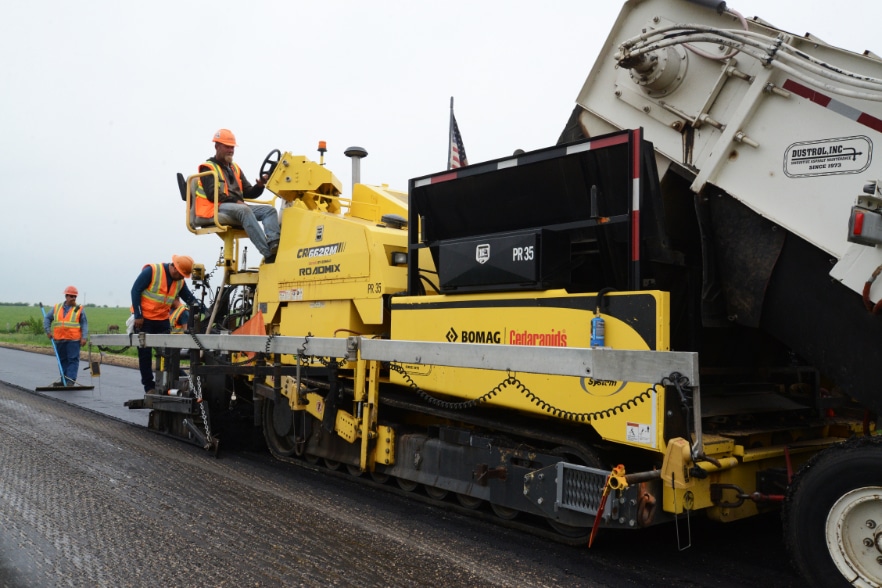
Butler County, Iowa, is moving toward hot in-place recycling (HIR) to leave a legacy of restored rural roads benefiting taxpayers, agriculture and light industry. To this end, in early summer 2022, just west of Cedar Falls, subcontractor Dustrol Inc., used the method on the surface of County Road T47 (Sinclair Ave.) from Iowa 57 north 12 miles to Iowa 3.
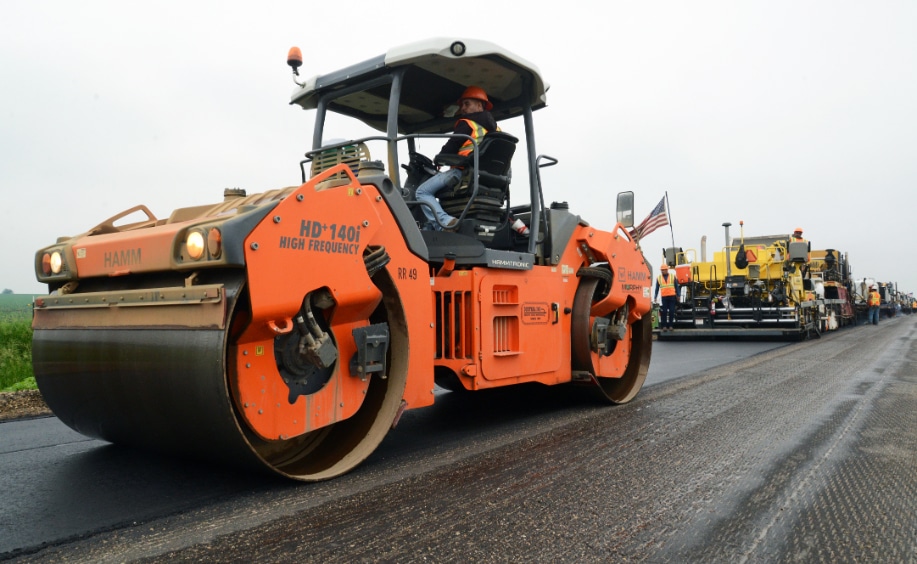
Breakdown compaction of the mat is provided by a double-drum, high frequency roller.
Butler County’s Challenge
Like many Iowa counties, Butler County is square in shape. It’s bisected by one state trunk highway north/south, and another east/west. “The secondary road system branches off them, to all communities, generally on a three-mile grid,” said John Riherd, P.E., P.L.S., Butler County engineer.
The county is responsible for approximately 400 lane miles of secondary roads, including drainage structures and bridges. Unpaved (gravel) roads total another 1,600 lane miles. “We have one section of Portland cement concrete that’s 1,100 feet long, otherwise everything else is asphalt,” said Tom Hoodjer, PLS, assistant engineer.
Other than funding, the county engineers say fighting cracks in pavement is their biggest challenge. “Keeping the surface crack-free so it drains well is most important,” Riherd said. “Cracks will kill your road more than anything else. One of the first things we do is fill the cracks. We try to either fill or eliminate the cracks so water’s not getting into the base and we’re holding that surface together.”
Heritage of Engineers
That the county roads aren’t plagued with potholes isn’t just a testament to staff keeping cracks filled, but to preceding civil engineers who knew how to build long-lived roads.
“The one thing we don’t generally have is a lot of potholes,” Hoodjer said. “The engineers before us spent a lot of time working on that base. The road system in Iowa was developed over time, and they had the foresight to make sure that they had constructed a good base before they paved it. They knew what they were looking to do.
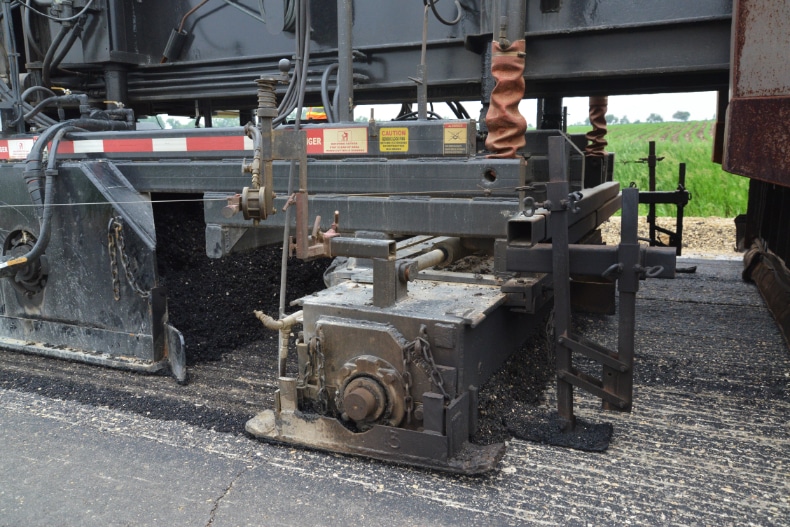
The milling head carves the heated pavement from substrate and channels it into a windrow.
“Also, another good thing for us is the availability of good limestone rock,” he added. “There have been quarries in all parts of the county and we still have most of them.” Indeed, one of Butler’s townships is named Shell Rock.
A typical road cross section in Butler is 6 inches of rolled, or compacted, stone, topped with 3/4-inch of seal coats, and later, 2 inches of hot-mix asphalt (HMA). Eight to 10 years later another inch or two of HMA would be placed and there would be 3 to 5 inches of asphalt on top of the base course.
“Around the early- to mid-1990s we began doing a lot of cold in-place recycling [CIR] in the county,” Hoodjer said. “At that point most asphalt pavement had 5 to 6 inches of asphalt and bituminous seal coat. At this time approximately 90% of the county roads have been cold in-place recycled.”
Move to Hot-In-Place
Over the years the layers of cold in-place recycled (CIR) asphalt rose higher and higher, and Butler County began to look at alternatives such as HIR.
Riherd said 2021 saw the county’s first trial of HIR. “We had a cold in-place program but started to get to a point where we asked, how much is too much cold-recycled pavement? We had some roads which were cold in-place-recycled in the 90s, and hit ’em again, cold in-place-recycling the either 2- or 3-inch cap that was on that, and into the old cold-recycle. At that point we were getting to 6, 7 inches of a cold- recycled mix, and then a 3-inch cap of asphalt on top. We didn’t know if that was really a good thing to continue to build these pavements up.”
Staff also began to see the function of the cold-recycled layer in a different light.
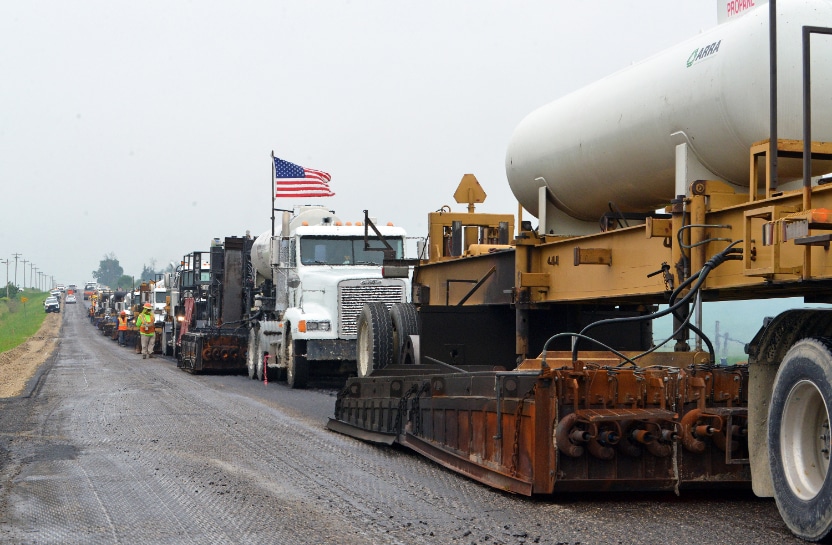
The preheater unit leads the eight-unit HIR train at work on Sinclair Ave.
“We saw that cold recycle as a stress relief layer, a crack prevention layer, not necessarily a load-carrying layer,” Hoodjer said. “And we became concerned about having too much of the ‘softer’ mix in the middle of this pavement. We saw industry promoting hot in-place and thought that would be a good way to deal with that.
“That is, we’re planning to leave that CIR layer alone, essentially, but work with that 3-inch cap because that’s where the wear is. The cold in-place layer still is doing its job under there, but now we’re seeing some cracking in that cap. That’s what we saw with Sinclair Ave.”
Due perhaps to loads of stone headed to a different project on Sinclair Ave. from a local quarry, rutting began to appear shortly after it was resurfaced. “We felt it saw a lot of abuse in its first year or two of life and rutted because of that,” Riherd said. “We like to restore the cross-section before we in-place recycle, so we milled a nominal 3/4-inch to 1-inch to create a cross-slope again, and to generate RAP for a new cap and give the recyclers a good chance for a uniform surface.”
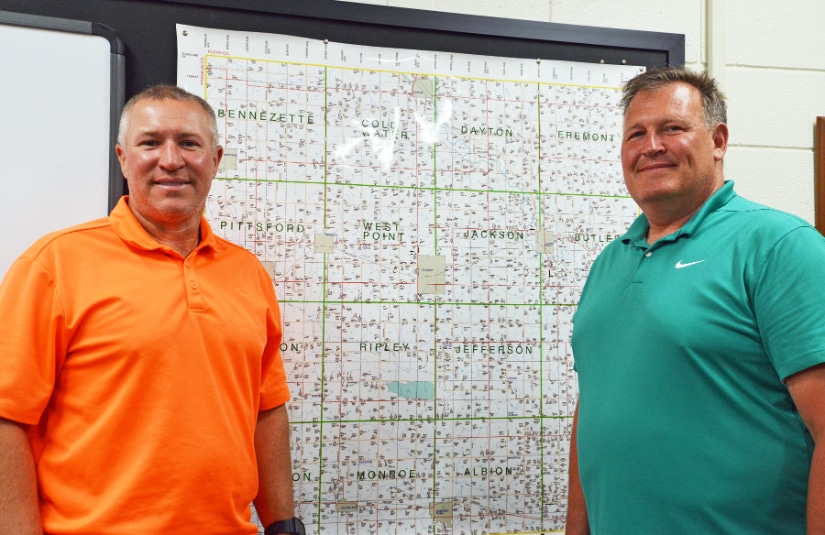
Tom Hoodjer and John Riherd
On Sinclair Ave., cores taken earlier were analyzed by consultant Road Science, a division of Arkema, which came up with the recycle mix design. The surface was recycled with HIR to a depth of 2 inches. This included preparing the surface by milling, softening the surface via uniform heating, and mixing with a rejuvenating agent, and spreading, leveling, and compacting the mixture for surfacing.
The rejuvenating agent was composed of a polymer modified asphalt emulsion, containing 3% styrene-butadiene solution polymer.
The final recycled course was compacted by a Hamm double-drum HD+ 140i high-frequency roller in breakdown position, followed by a Hamm double-drum HD+ 140i VO finish roller in oscillation mode, compacted to minimum 95% density.
The prime contractor, Heartland Asphalt Inc., of Mason City, Iowa, would then place a 3-inch HMA friction course in two 1.5-inch lifts.
Unique HIR System
Dustrol’s eight-unit HIR train has four units pulled by tractor cabs, and four pushed by the heater mill units. “Each of the eight heaters and heater mills have an operator, who does not drive the truck, but operates the equipment,” said Ron Wilson, vice president for Dustrol.
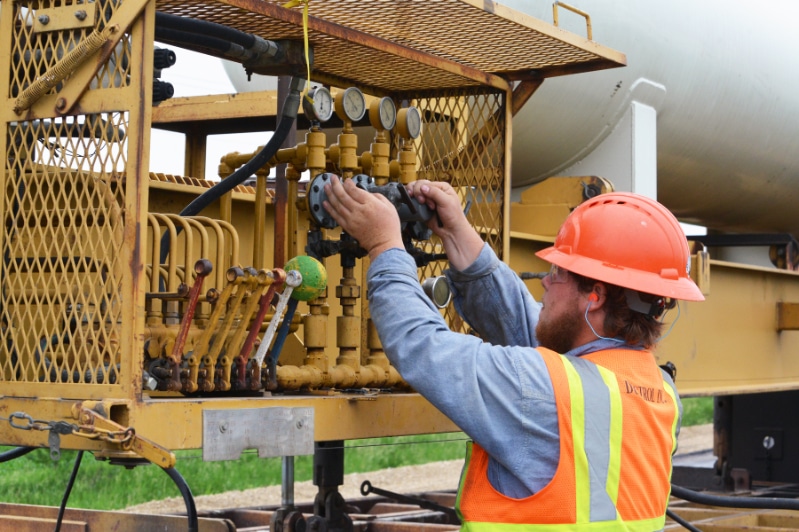
Dustrol’s MARS process, which stands for Mobile Asphalt Recycling System, is the contractor’s current method of hot in-place recycling asphalt 2 inches or more. The process begins with one custom-made, propane-fueled preheater. The next heater in the train is equipped with grade-controlled milling drums, which windrow the top 1/2 to 3/4 inch of softened material. The milling heads are capable of cutting 16 feet wide.
Tunnel heaters follow, heating the underlying pavement while maintaining the temperature of the windrow in the tunnel. The surface again is milled and heated by up to three more milling heaters alternating with tunnel heaters, depending on material and depth. The last milling heater in the process has an oil metering system that injects and mixes the rejuvenating agent into the milled asphalt and aggregate.
“We don’t have a direct flame going down to heat,” Wilson said. “Instead, the flames heat fire brick within the unit’s ‘oven.’ It helps us retain heat and is better than insulation only. It’s a gentle heat above 200 degrees F that is not very long on the surface, as we are trying to go 20, 30 or 40 fpm; we are not exposing it deeply to very hot temperatures.”
This protects the recycled material from premature aging caused by excessive production temperatures. “Yet, there is a degree of burning some of the volatiles out,” Wilson said. “That’s why we are replacing them with a quality rejuvenator and polymer modifier at the end of the process.”
The rejuvenating agent is added just ahead of the paver, chemically reacting with the material. Finally, after adding and mixing the rejuvenating agent, the windrow of material is picked up with a conventional windrow elevator, modified by Dustrol. The paving of the recycled material is done with a conventional electronic grade control/electric screed paver, in Butler County, using Dustrol’s Bomag Cedarapids CR662RM rubber-tracked paver.
The material is compacted using conventional rollers. The road can be opened to traffic after a cool-off period similar to an asphalt paving operation, typically within an hour after the process is complete.
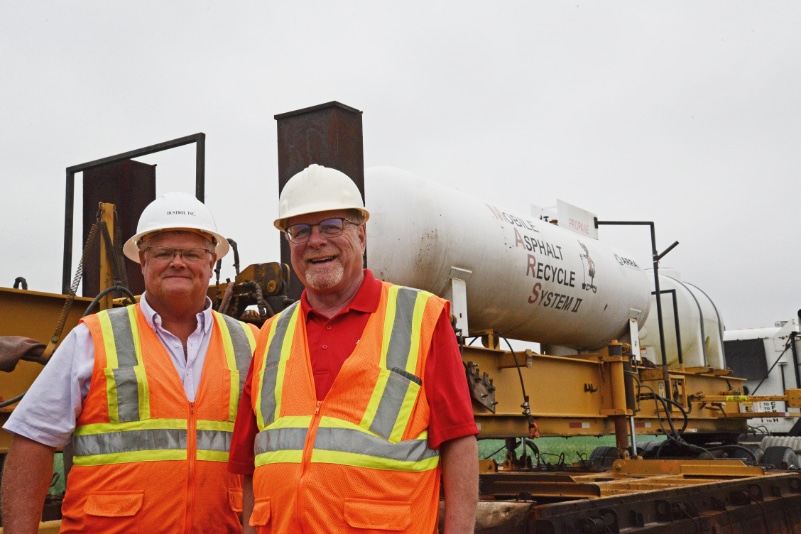
Ron Wilson & Donn Johnson
“Our equipment can go from 13 to 16 feet wide,” said Donn Johnson, consultant for Dustrol. “In this application we are working 12 feet wide. It’s originally a 22-foot roadway and they’ve added a foot to either side, which is recycled in-place, so we will wind up with a beautiful 24-foot pavement after processing.”
“We make all our own equipment, the heaters, of course,” Wilson said. “The pavers and rollers are conventional. We modified the windrow elevator because we can’t really find a windrow elevator we like well enough, so we extended it upward, so it dumps in the paver a little differently. We tend to modify just about everything, but the heaters, heater-tractors, milling drums, even the scarification equipment is all built by us. We manufacture for ourselves and do our own construction.”
The preheater/heater-miller/heater-scarifying/tunnel heater system allows Dustrol to reduce project costs and improve project timeliness. “We do everything on-site,” Johnson said. “We don’t haul materials off for mixing or processing. This speeds up timelines and reduces our fuel consumption, in turn providing lower-cost maintenance for removing cracks, ruts and low areas on existing surfaces, as well as offering environmental advantages like much lower fugitive dust emissions during reconstruction.”
Traffic delays are minimal as the process is fast at 20 to 40 fpm, allowing the contractor to repair 2 to 4 lane-miles per day.
“Dustrol can complete the HIR process as either a single-lift or multiple-lift rejuvenation,” Wilson said. “In the single-lift method, scarifiers loosen the heated material to a depth of up to 1 inch. The multiple-lift operation allows for the rejuvenation to go to 2 inches or more using milling heads to loosen the material.” Both processes allow surfacing to be placed the same day, or up to weeks later if necessary.
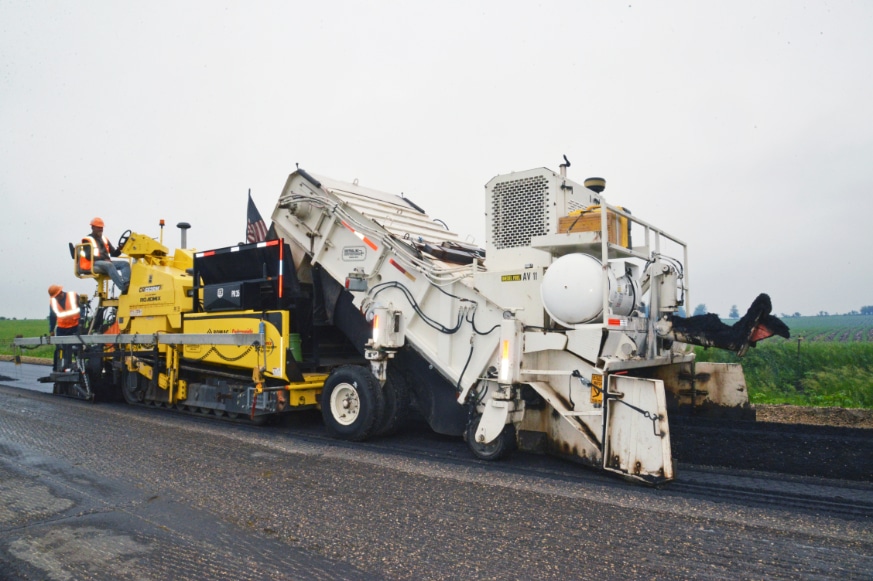
Destructive Loadings
On Butler County roads, passenger cars don’t provide the kind of destructive loading that causes pavements to deteriorate, nor do most agricultural hauls of hay or harvested products if they are distributed over the proper number of axles, Butler County’s Riherd said. But large-scale cattle and hog confinement operations generate hauls of manure that are taken to fields as fertilizer and are very heavy.
“The hauls of manure are pretty hard on our roads,” he said. “Additionally, recent legislative action has permitted the allowable axle weights to increase, which will undoubtedly cause our roads to wear much faster than they do with today’s axle weights.”
“One of the biggest variables in our system is pavement age,” said Butler County’s Riherd. “Nearly every road in the county has the same base, and it has the same weather and same traffic. So, a lot of what we do is age-based. We don’t have a formal pavement management program; instead, we have a starting point in which we know which roads are of a certain age. We will drive them and see what the crack count is, and how the ride is.”
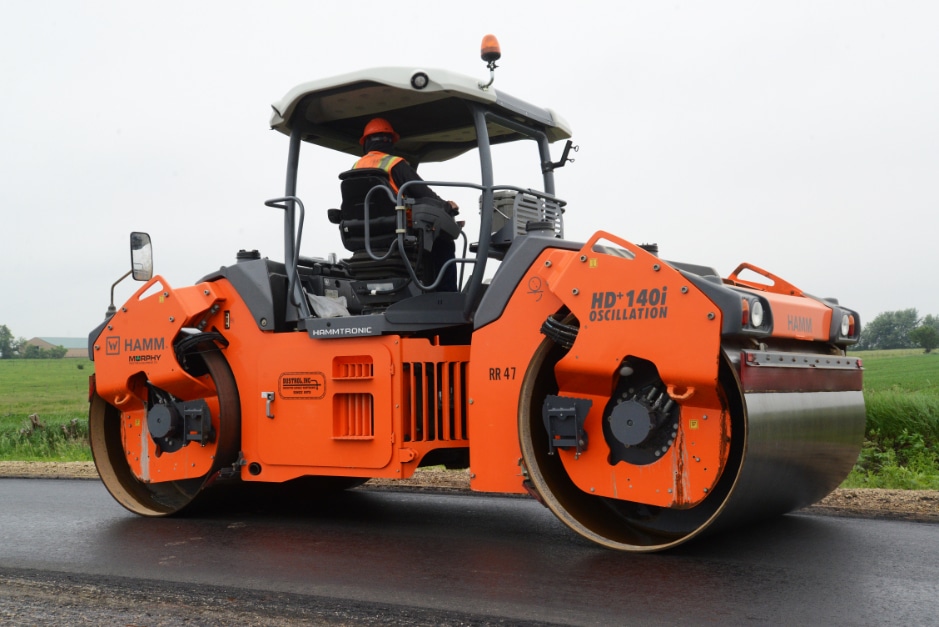
The pavement condition then is measured, but without a great deal of variance among pavements. “We don’t have a red spot on the map for bad conditions, or orange or green or whatever the color is. Instead, most roads have the same characteristics regarding pavement condition index. We stay aware of their condition as we have a reasonable assumption that we’re going to have this many dollars to spend in the next five years. We ask, ‘where will we spend this money?’”
A main source of revenue for Butler County’s rural roads is the Iowa Farm-to-Market road account. “That’s a road use tax funding coming from the state fuel tax and vehicle registration fees,” Riherd said. “It’s a formula based on your area, your number of road miles, and it’s distributed throughout the state. Another source would be federal aid on a portion of our system, that is programmed through our region. But most of the time our farm-to-market account is what we use.” The county’s annual secondary road budget is around $8 million to $9 million.
Riherd said none of this would be possible without the confidence and support of the county’s board of supervisors.
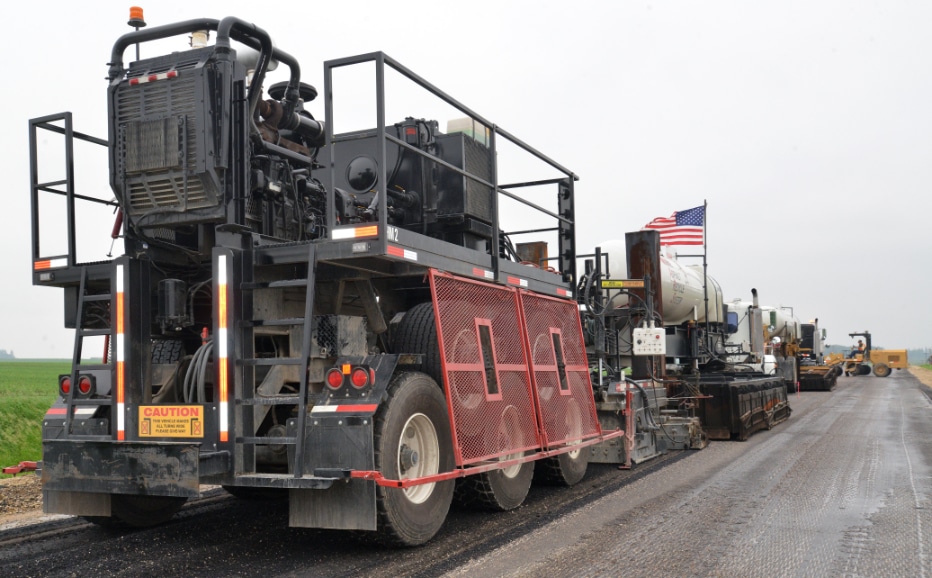
“We have a very supportive board of supervisors who are the elected leadership of the county, and they’re ultimately responsible to the taxpayers,” he said. “They’re the ones who determine the tax levies in the county and recycling is important to them because it makes the best use of our tax dollars.
“And that’s what we’re attempting to do here as well, make the best use of our tax dollars, building a good road that will last many years,” he added. “What might be a small maintenance project is more of an investment in a high-quality road that the supervisors can be proud of.”
Edited from editorial content provided by Dustrol Inc. This article previously appeared in Pavement Preservation Journal. Used with permission.
